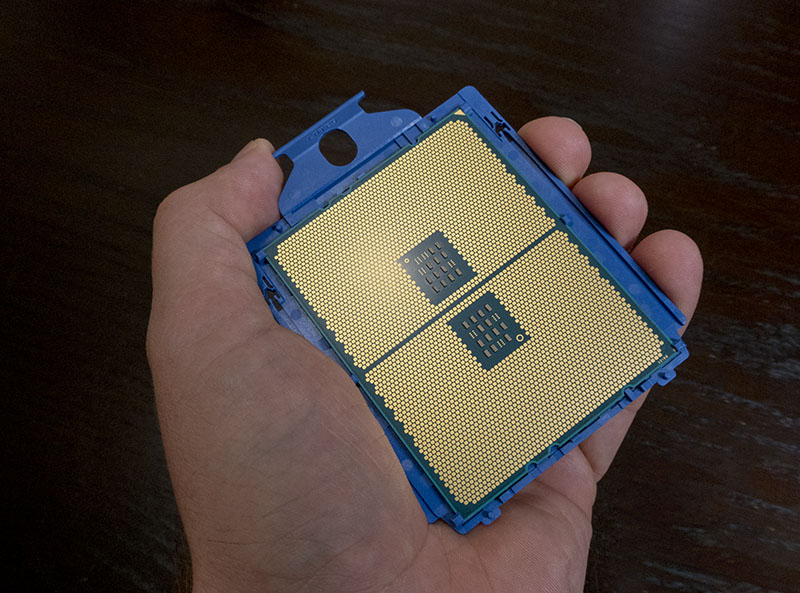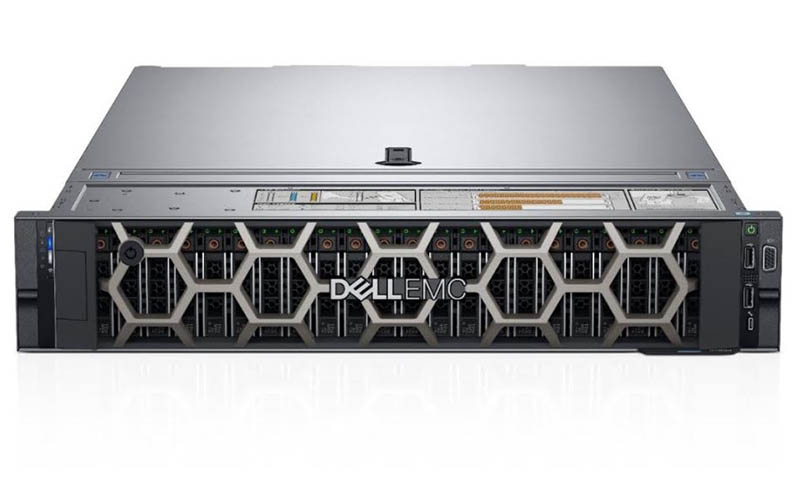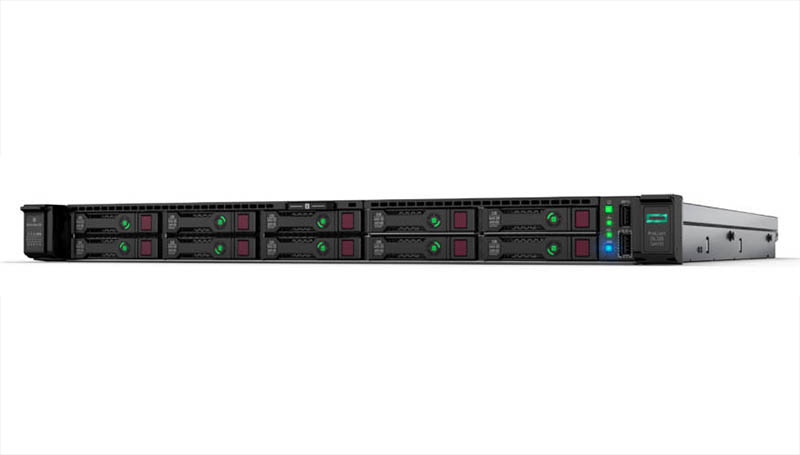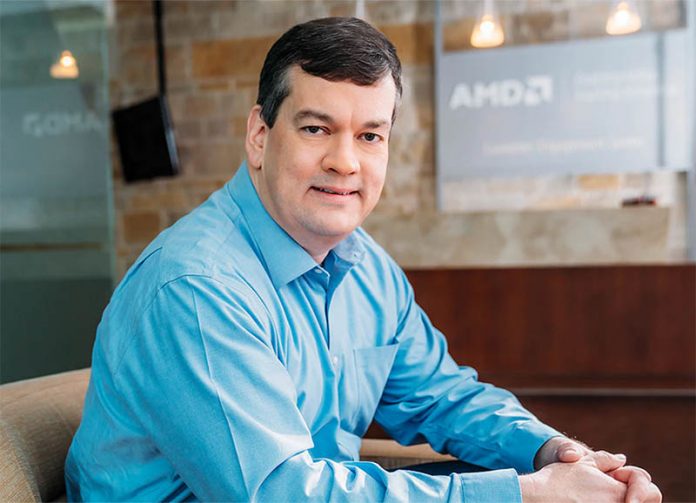After AMD’s keynote at Computex 2019, I had the opportunity to sit-down with Forrest Norrod for a few minutes and chat about the server industry, and where AMD is headed. Forrest is SVP and GM of AMD’s Datacenter and Embedded Solutions Business Group. He is also the executive holding what many in the server industry regard as the most highly anticipated server chip release of 2019: the second generation AMD EPYC codenamed “Rome.” In my travels talking to server vendors across the globe, customers, resellers, and ISVs, the Rome hype is palpable even in casual conversation.
Since we only had 35-40 minutes to chat, some of the questions I asked required fairly complete industry perspective. Forrest has this perspective, but I am conscious that all of our readers may not have the same background. Below are the nine key topics we discussed, along with with my notes from the discussion and some extra context and perspective from my side.

Product Strategy Questions
S1. Price wise, a 64-core Rome CPU offers more capabilities than what Intel Xeon has out today, is there any sense of where pricing should land? Are 64-core Rome parts going to be priced more like the Intel Xeon Platinum 8280 or Intel Xeon Platinum 9200?
Forrest’s response to this he asked me specifically not to quote verbatim. After speaking about this, my sense was:
- Forrest agrees that most customers are not paying $10,000+ for an Intel Xeon Platinum 8280 chips.
- Forrest declined to give pricing guidance. Instead, I got the sense that AMD may look to increase the street price of 64-core parts over the 32-core AMD EPYC 7601, but I also got the sense that AMD is going to try to be more realistic on pricing and not go to a high list price/ high discount model that Intel is using at the high-end.
- Street price of the current generation “Naples” is not equal to list price. I can say that at STH the AMD EPYC systems we purchase for some of our infrastructure deployments are not using list price AMD EPYC 7401P chips. This is normal in the industry.
- I did not get the impression that AMD was going to price a 64-core Rome CPU at the same level as the Intel Xeon Platinum 9200 series, let alone an Intel Xeon Platinum 8280L.
S2. There has been a lot of talk about high-end parts, but do you have any plans to address lower-end segments? (e.g. the Intel Xeon E-2100/ Xeon E-2200 series?)
- This one surprised me a bit. As we discussed this, Forrest seemed to be focusing more on the mainstream market, rather than the lower-performance market.
- Personally, I think a Ryzen with unbuffered ECC, or better yet, RDIMM support would be a category killer for the low-end UP server market.
- My sense is that the TAM for this market is too low for AMD to prioritize versus the mainstream market.
S3. Does AMD have any plans to support Compute Express Link also known as CXL?
I asked this, fully expecting to get a “no.” Instead, Forrest was more diplomatic and thoughtful in his response.
- AMD has not announced CXL support yet.
- AMD will monitor CXL. If it is open, and truly open, is something that AMD will look at.
- If there is a push in the silicon industry for CXL, AMD will consider adopting it.
- Forrest was careful not to say that AMD will never support CXL. He just said that AMD wanted to ensure that it would be adopted in the market and is a truly open standard.
S4. It seems AMD is pushing for a model where there is a strong CPU at the center of an accelerated platform. Is that correct? What feedback are you getting on that messaging?
- Forrest gave me an “absolutely” here.
- After discussing this with Forrest, I think it is fair to say that AMD is not just trying to be the best platform for AMD CPUs combined with AMD GPUs. Instead, AMD wants to provide the platform that other hardware companies, and those that write software for big hardware, want to be on.
- I think this is really interesting. AMD is providing a larger Rome platform with more PCIe I/O. Extended PCIe connectivity means that one can add more storage and more accelerators. That goes alongside having more DIMM channels than Intel’s mainstream parts.
- If you read our IDC 1Q19 Quarterly Server Tracker Dell EMC Top and Inspur Grows discussion piece, you will see contracting unit shipment volume with higher ASP. A driver of higher ASP is putting more capability into a single box. Here, AMD EPYC Rome is set to deliver a more expandable platform at a time when the industry trend is consolidating to fewer machines with more resources per machine.

Market and Competitive Landscape Questions
M1. Are you seeing a strong ABI (Anything But Intel) pull in the market?
- Forrest said not really. Instead, they are seeing the pull of having a new platform with more capabilities.
- What was interesting with this response is that ABI very commonly heard when speaking to Arm server vendors. AMD due to compatibility has a much easier path to convert Intel Xeon sockets to AMD EPYC sockets. One would think that if ABI was a strong force, AMD would be one of the biggest beneficiaries.
M2. Intel is using the Xeon Platinum 9200 series as a halo product for marketing. Are you hearing any impact from your customers about this marketing?
- Forrest told me that they are not seeing an impact with most customers.
- His reasoning was that buyers for servers are generally more sophisticated and know the difference between mainstream platforms and niche platforms.
- My sense is that Intel is fairly effective getting Platinum 9200 figures competitively out there, although we explained some challenges in Why the Intel Xeon Platinum 9200 Series Lacks Mainstream Support.
- We had a bit of discussion about the AMD EPYC Rome 64-core NAMD benchmark, and Intel’s response. See our piece AMD EPYC Rome NAMD and the Intel Xeon Response at Computex 2019 for more here.
M3. What are the segments most interested in the next-generation AMD EPYC Rome family? Is it the GPU compute segments, storage segments, or other parts of the market?
- Here Forrest said essentially all of these markets.
- From my discussions with vendors of systems, accelerators, and storage, Rome has the industry buzzing. Forrest was well aware that his next-generation product had a lot of industry buzz.
M4. How does AMD compete with the huge marketing funds that Intel feeds the industry and that many companies rely on?
- For those who are not aware, in the industry, Intel provides marketing support funds to their partners. Intel has some strict requirements to claim these funds. Examples include the partner logo and Intel logo need to be the same size. Logos in a trade show booth cannot be too low (e.g. must be above normal booth table height.) This extends even to sales collateral where you see the Intel logo featured prominently alongside the partner’s logo. To those who are in the industry, this is the way things operate. It provides significant headwinds to competitors.
- Forrest had a very pragmatic view here. He suggested that there are a few items that AMD needed to execute well on.
- He suggested that there are a number of reasons that people buy servers. Among those reputation, performance, and even sales representative recommendations.
- Rome is designed to have leadership performance capabilities that he expects will generate customer demand. He expects that as they raise general awareness, customers will ask their sales reps for AMD EPYC solutions and sales reps will sell what their customers demand.
M5. Does the ecosystem need to be faster to support Rome than Naples to capitalize on the market before Intel “Ice Lake” Xeons arrive?
- Here is some background. Next-generation Intel Xeon chips codenamed “Ice Lake” we expect to have 8-channel memory along with PCIe Gen4 and Intel has offered small glimpses at their next-generation parts. These new Xeons are not the Cascade Lake parts launched in Q2 2019. Instead, we expect them in 2020. That means if you want a mainstream server CPU (not Cooper Lake) that has the memory bandwidth and PCIe Gen4 speeds in 2019, AMD EPYC Rome is going to be the option. When the current EPYC generation came out in 2017, it took several months or quarters for large OEMs like HPE and Dell EMC to sell ProLiant and PowerEdge servers. If they take a similar amount of time, Intel may be nearing its next-generation shortly thereafter.
- Forrest mentioned that Naples was about getting the first 5% market share and getting the ecosystem back to AMD. Naples was viewed as an ecosystem primer.
- Most current models will support Rome CPUs with a BIOS flash. Forrest acknowledged that new servers (motherboards) would be needed in many cases to utilize PCIe Gen4.
- Forrest was very optimistic about the work AMD has done with its OEM partners. From his perspective, he was aware of the need to have systems ready faster. Naples was the enabler for this generation.
- Although he did not say anything definitive, and not sharing anything I know from talking to server vendors, my sense from Forrest was that he was confident that AMD’s partners would deliver servers supporting Rome in a timely manner.

HPE ProLiant DL325 Gen10 Front
Final Words
Speaking with Forrest is always a treat. Here is someone who has an entire industry excited about a next-gen product, yet he is very measured in his thought process and approach. Even with a strong design, Forrest realizes that there are other market forces at work and has a pragmatic methodology to address market challenges. At the same time, Forrest is an engineer at heart. It is painfully obvious behind the measured demeanor that he is an engineer that knows he has a killer product launching.
Stay tuned to STH for complete AMD EPYC “Rome” generation coverage as we get into the launch cycle next quarter.





I don’t see many exec interviews that use this format, but I really like it. You’re someone who isn’t just sitting with a microphone but you’re a top industry analyst without that moniker. I read STH because you’re adding a broad perspective not just repeating what PR has told you.
I’d like to see you at a bar or on stage one day talking with people like Forrest N. That’d be fascinating.
Why didn’t you just ask him prices of Rome chips? Why not ask GHZ and power? You missed an opportunity here.
What is stronger: Rome hype or The Force?
When I read that part about the Intel MDF I showed it to our head of engineering. We’re a mid-sized ISV. He was like, “finally someone gets that it isn’t just about specs”
I’m with brianmc as I don’t think this is standard, but I like your editorial perspective. That article looking at both sides of the NAMD benchmarks last week was so insightful. You’ve got to do more of these to combat the junk Forbes now publishes
>Why didn’t you just ask him prices of Rome chips? Why not ask GHZ and power? You missed an opportunity here.
Waste of a question, waste of time. He’s not going to reveal stuff like that at an interview.
When will Rome come out? I haven‘t seen any exact release dates
Can I sign up to be a fly on the wall for the next one you do? All I’m thinking about is how much was said off the record. That part about “ABI” had so much insight, and Mr. Norrod’s response I wouldn’t have expected.
I’d agree with some of the previous posters. I come here because we use your reviews for our marketing servers to customers and we don’t have the resources you have in our country. I now visit at least once a day to check what’s new.
I used to be a sysadmin in a past life. I never liked the channel. The reps were parsiminous with info and were clearly paid to try to direct buying decisions to benefit the bottom line, not me the customer.
I don’t know for sure what it implies: What if AMD did away with the channel? Would it reduce impedance?
It’s interesting what you say about discounts and no one paying the list price.
It’s pretty normal for CPUs to be discounted after being on the market for a couple of years
If you look at consumer CPUs, the market price always goes down over time – for instance Ryzen 2700 is discounted by 26% and it has only been on the market one year. EPYC has been in the market for more than 2 years, so a discount should be expected.